The revitalization of giant otters in Ecuador
The giant otter, Pteronura brasiliensis, is the longest and largest of all otters. They can reach up to 2 meters in length, and weigh between 26kg to 34kg depending on the individual and their gender. It is also the largest species of the entire mustelid class which includes carnivorous mammals such as weasels, badgers and wolverines.
 Due to their formidable size and speed, giant otters are apex predators known as “River Wolves”. They compete successfully with Jaguars and fully-grown Caiman for food in their natural habitats. It doesn’t hurt that their whiskers, or vibrissae, are highly attuned organs of touch that detect water pressure and movement in the current which helps them pinpoint the location of their prey. They frequently hunt together as a team, otherwise known as a “romp” on land and a “raft” in the water. They eat a wide variety of creatures such as many species of fish (including piranha!), crabs, turtles, small caiman, small anaconda, and anything else that is readily available because they need to eat up to 4kg of meat per day to maintain a healthy diet.
Due to their formidable size and speed, giant otters are apex predators known as “River Wolves”. They compete successfully with Jaguars and fully-grown Caiman for food in their natural habitats. It doesn’t hurt that their whiskers, or vibrissae, are highly attuned organs of touch that detect water pressure and movement in the current which helps them pinpoint the location of their prey. They frequently hunt together as a team, otherwise known as a “romp” on land and a “raft” in the water. They eat a wide variety of creatures such as many species of fish (including piranha!), crabs, turtles, small caiman, small anaconda, and anything else that is readily available because they need to eat up to 4kg of meat per day to maintain a healthy diet.
 Giant otters have a preference for undisturbed black water creeks and rivers with gentle water flow and high fish density. They need areas with both gently sloping and high riverbanks protected by overhanging vegetation for their communal latrines and safe denning sites, known as “holts”, where kits can be born and raised safely for 2 months before venturing out and learning how to swim. A typical family group consists of 2-15 members composed of a monogamous pair, non-breeding subadults (which are frequently their older offspring), and a couple generations of young offspring. An average of 2 kits are born in a litter each year, and the family’s overall success depends on the group’s size, their habitat quality, and the availability of prey.
Giant otters have a preference for undisturbed black water creeks and rivers with gentle water flow and high fish density. They need areas with both gently sloping and high riverbanks protected by overhanging vegetation for their communal latrines and safe denning sites, known as “holts”, where kits can be born and raised safely for 2 months before venturing out and learning how to swim. A typical family group consists of 2-15 members composed of a monogamous pair, non-breeding subadults (which are frequently their older offspring), and a couple generations of young offspring. An average of 2 kits are born in a litter each year, and the family’s overall success depends on the group’s size, their habitat quality, and the availability of prey.
 The giant otter is currently listed as “Endangered” on the International Union for Conservation of Nature’s Red List. The species is in peril due to rampant hunting for their pelts in the past, and the compounded effects of human activities leading to contamination and habitat loss from agricultural practices, mining, and oil extraction. Another important factor that leaves the species at risk is the fact that only 1/4 to 1/3 of the total population reproduces at any given time due to late maturity, a later breeding age, and low survival of the young due to the loud and conspicuous social nature of these animals which makes them a target for other predators.
The giant otter is currently listed as “Endangered” on the International Union for Conservation of Nature’s Red List. The species is in peril due to rampant hunting for their pelts in the past, and the compounded effects of human activities leading to contamination and habitat loss from agricultural practices, mining, and oil extraction. Another important factor that leaves the species at risk is the fact that only 1/4 to 1/3 of the total population reproduces at any given time due to late maturity, a later breeding age, and low survival of the young due to the loud and conspicuous social nature of these animals which makes them a target for other predators.
 Since their habitat requirements are all met beautifully within Yasuni National Park, this region of the Ecuadorian Amazon is an extremely important center for species recovery and revitalization. Thanks to the conservation efforts of the Kichwa Añangu Indigenous Community, the local giant otter population has been able to thrive! In the past few years, the local Añangu Lagoon family reached up to 9 members before some of the subadults migrated in search of their own territories in order to establish families of their own. There are currently 6 members in the local family thanks to the new addition of an adorable baby! Statistics indicate that there are approximately 32 of these incredible creatures throughout this region.
Since their habitat requirements are all met beautifully within Yasuni National Park, this region of the Ecuadorian Amazon is an extremely important center for species recovery and revitalization. Thanks to the conservation efforts of the Kichwa Añangu Indigenous Community, the local giant otter population has been able to thrive! In the past few years, the local Añangu Lagoon family reached up to 9 members before some of the subadults migrated in search of their own territories in order to establish families of their own. There are currently 6 members in the local family thanks to the new addition of an adorable baby! Statistics indicate that there are approximately 32 of these incredible creatures throughout this region.
 Giant otters have extremely soft fur which is an overall chocolaty-brown colour, except for the fur covering their long necks. The patchy patterns of brown and creamy white on the underside of their throats are unique to each and every one, similar to how a Jaguar’s spots are unique to each individual. Have a look at the beautiful markings adorning some of the 6 current members of this single family. Evidently, Yasuni National Park is one of the best places on Earth to see giant otters up close and personal in their natural habitat!
Giant otters have extremely soft fur which is an overall chocolaty-brown colour, except for the fur covering their long necks. The patchy patterns of brown and creamy white on the underside of their throats are unique to each and every one, similar to how a Jaguar’s spots are unique to each individual. Have a look at the beautiful markings adorning some of the 6 current members of this single family. Evidently, Yasuni National Park is one of the best places on Earth to see giant otters up close and personal in their natural habitat!
 Diego Escobar is Marketing Director at Napo Wildlife Center. Napo Wildlife Center is an eco-lodge offering unforgettable experiences in the Amazon rainforest of Ecuador, inside Yasuni Biosphere Reserve, which is managed by the Añangu kichwa aboriginal community.
If you would like to be a guest blogger on A Luxury Travel Blog in order to raise your profile, please contact us.
Diego Escobar is Marketing Director at Napo Wildlife Center. Napo Wildlife Center is an eco-lodge offering unforgettable experiences in the Amazon rainforest of Ecuador, inside Yasuni Biosphere Reserve, which is managed by the Añangu kichwa aboriginal community.
If you would like to be a guest blogger on A Luxury Travel Blog in order to raise your profile, please contact us.
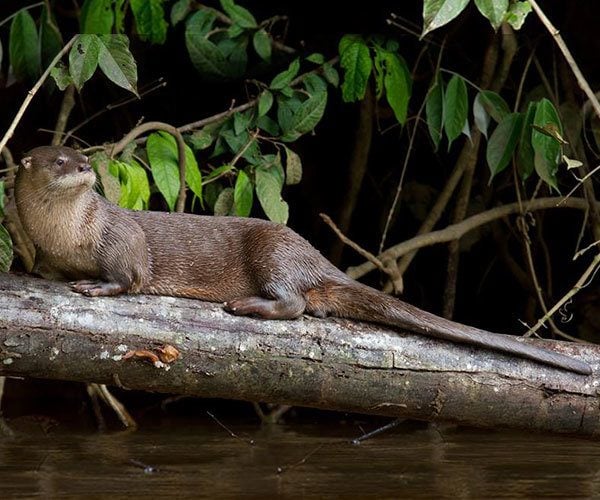 Due to their formidable size and speed, giant otters are apex predators known as “River Wolves”. They compete successfully with Jaguars and fully-grown Caiman for food in their natural habitats. It doesn’t hurt that their whiskers, or vibrissae, are highly attuned organs of touch that detect water pressure and movement in the current which helps them pinpoint the location of their prey. They frequently hunt together as a team, otherwise known as a “romp” on land and a “raft” in the water. They eat a wide variety of creatures such as many species of fish (including piranha!), crabs, turtles, small caiman, small anaconda, and anything else that is readily available because they need to eat up to 4kg of meat per day to maintain a healthy diet.
Due to their formidable size and speed, giant otters are apex predators known as “River Wolves”. They compete successfully with Jaguars and fully-grown Caiman for food in their natural habitats. It doesn’t hurt that their whiskers, or vibrissae, are highly attuned organs of touch that detect water pressure and movement in the current which helps them pinpoint the location of their prey. They frequently hunt together as a team, otherwise known as a “romp” on land and a “raft” in the water. They eat a wide variety of creatures such as many species of fish (including piranha!), crabs, turtles, small caiman, small anaconda, and anything else that is readily available because they need to eat up to 4kg of meat per day to maintain a healthy diet.
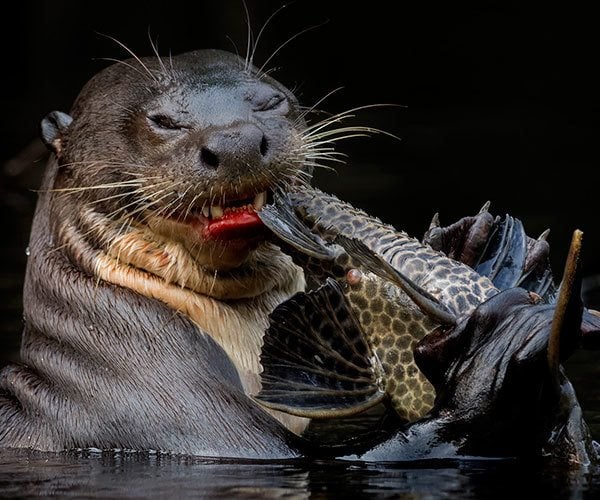 Giant otters have a preference for undisturbed black water creeks and rivers with gentle water flow and high fish density. They need areas with both gently sloping and high riverbanks protected by overhanging vegetation for their communal latrines and safe denning sites, known as “holts”, where kits can be born and raised safely for 2 months before venturing out and learning how to swim. A typical family group consists of 2-15 members composed of a monogamous pair, non-breeding subadults (which are frequently their older offspring), and a couple generations of young offspring. An average of 2 kits are born in a litter each year, and the family’s overall success depends on the group’s size, their habitat quality, and the availability of prey.
Giant otters have a preference for undisturbed black water creeks and rivers with gentle water flow and high fish density. They need areas with both gently sloping and high riverbanks protected by overhanging vegetation for their communal latrines and safe denning sites, known as “holts”, where kits can be born and raised safely for 2 months before venturing out and learning how to swim. A typical family group consists of 2-15 members composed of a monogamous pair, non-breeding subadults (which are frequently their older offspring), and a couple generations of young offspring. An average of 2 kits are born in a litter each year, and the family’s overall success depends on the group’s size, their habitat quality, and the availability of prey.
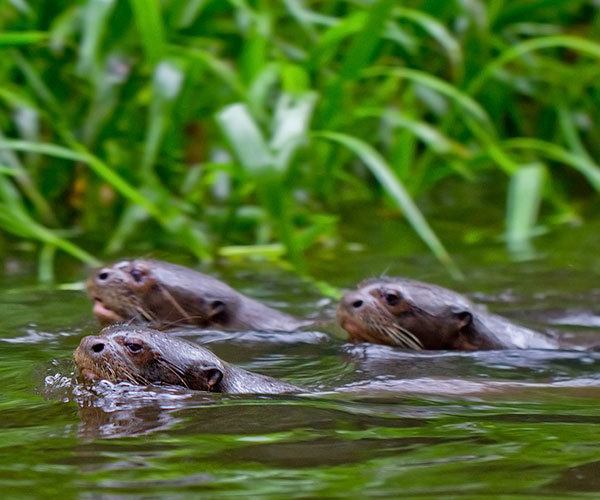 The giant otter is currently listed as “Endangered” on the International Union for Conservation of Nature’s Red List. The species is in peril due to rampant hunting for their pelts in the past, and the compounded effects of human activities leading to contamination and habitat loss from agricultural practices, mining, and oil extraction. Another important factor that leaves the species at risk is the fact that only 1/4 to 1/3 of the total population reproduces at any given time due to late maturity, a later breeding age, and low survival of the young due to the loud and conspicuous social nature of these animals which makes them a target for other predators.
The giant otter is currently listed as “Endangered” on the International Union for Conservation of Nature’s Red List. The species is in peril due to rampant hunting for their pelts in the past, and the compounded effects of human activities leading to contamination and habitat loss from agricultural practices, mining, and oil extraction. Another important factor that leaves the species at risk is the fact that only 1/4 to 1/3 of the total population reproduces at any given time due to late maturity, a later breeding age, and low survival of the young due to the loud and conspicuous social nature of these animals which makes them a target for other predators.
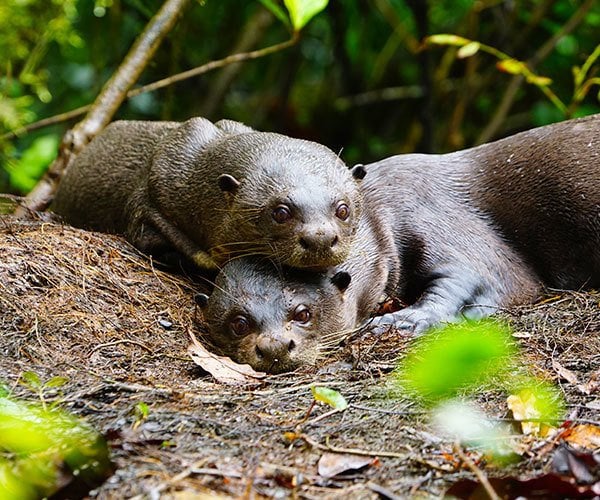 Since their habitat requirements are all met beautifully within Yasuni National Park, this region of the Ecuadorian Amazon is an extremely important center for species recovery and revitalization. Thanks to the conservation efforts of the Kichwa Añangu Indigenous Community, the local giant otter population has been able to thrive! In the past few years, the local Añangu Lagoon family reached up to 9 members before some of the subadults migrated in search of their own territories in order to establish families of their own. There are currently 6 members in the local family thanks to the new addition of an adorable baby! Statistics indicate that there are approximately 32 of these incredible creatures throughout this region.
Since their habitat requirements are all met beautifully within Yasuni National Park, this region of the Ecuadorian Amazon is an extremely important center for species recovery and revitalization. Thanks to the conservation efforts of the Kichwa Añangu Indigenous Community, the local giant otter population has been able to thrive! In the past few years, the local Añangu Lagoon family reached up to 9 members before some of the subadults migrated in search of their own territories in order to establish families of their own. There are currently 6 members in the local family thanks to the new addition of an adorable baby! Statistics indicate that there are approximately 32 of these incredible creatures throughout this region.
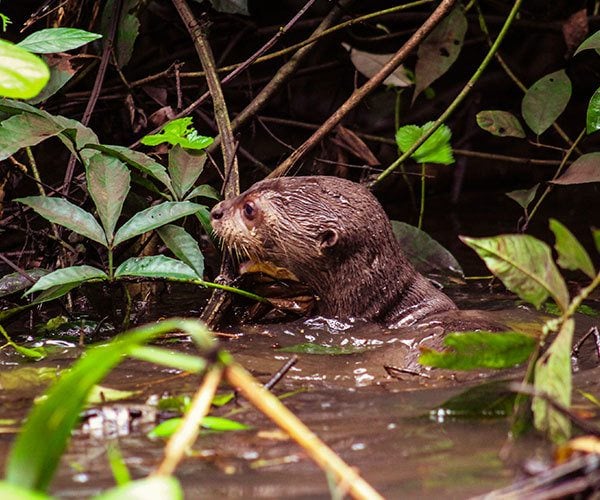 Giant otters have extremely soft fur which is an overall chocolaty-brown colour, except for the fur covering their long necks. The patchy patterns of brown and creamy white on the underside of their throats are unique to each and every one, similar to how a Jaguar’s spots are unique to each individual. Have a look at the beautiful markings adorning some of the 6 current members of this single family. Evidently, Yasuni National Park is one of the best places on Earth to see giant otters up close and personal in their natural habitat!
Giant otters have extremely soft fur which is an overall chocolaty-brown colour, except for the fur covering their long necks. The patchy patterns of brown and creamy white on the underside of their throats are unique to each and every one, similar to how a Jaguar’s spots are unique to each individual. Have a look at the beautiful markings adorning some of the 6 current members of this single family. Evidently, Yasuni National Park is one of the best places on Earth to see giant otters up close and personal in their natural habitat!
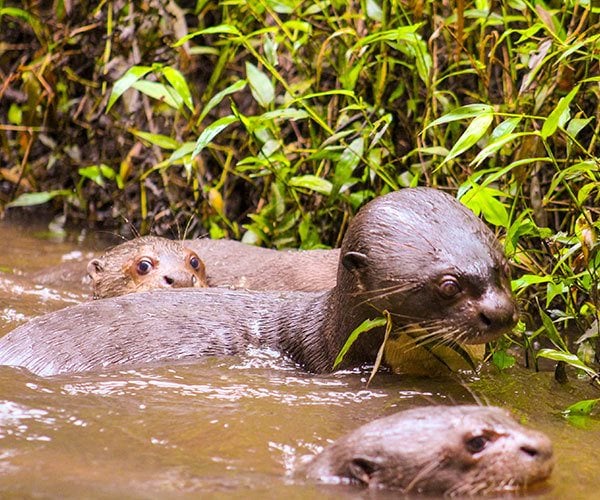 Diego Escobar is Marketing Director at Napo Wildlife Center. Napo Wildlife Center is an eco-lodge offering unforgettable experiences in the Amazon rainforest of Ecuador, inside Yasuni Biosphere Reserve, which is managed by the Añangu kichwa aboriginal community.
If you would like to be a guest blogger on A Luxury Travel Blog in order to raise your profile, please contact us.
Diego Escobar is Marketing Director at Napo Wildlife Center. Napo Wildlife Center is an eco-lodge offering unforgettable experiences in the Amazon rainforest of Ecuador, inside Yasuni Biosphere Reserve, which is managed by the Añangu kichwa aboriginal community.
If you would like to be a guest blogger on A Luxury Travel Blog in order to raise your profile, please contact us.Did you enjoy this article?
Receive similar content direct to your inbox.


Respect! Any creature that competes with jaguars and caiman for dinner gets my respect.
As ever I expect that it will be man that will be the otter’s biggest problem.
We need more places like Yasuni National Park to provide protected habitat for species (endangered or not) to thrive. I wish there’d be more all over the world and that we can save more animals for future generations.
Thought you might be interested in our experience with the Giant Otters in the Amazon Rainforest:
https://www.aluxurytravelblog.com/2019/02/17/discovering-the-amazon-in-peru/
I had no idea these giant otters were called Pteronura brasiliensis, or where they resided. They can get pretty big at 34kg and 2 meters so I can see why they get the nickname “River Wolves”. It’s incredible they use such finely attuned touch sensations with their whiskers as a guide and to find prey, they really are more intimidating than what I associate with otters generally. It’s awful to think a combination of factors, probably mankind predominantly, have put them at such danger. I think the Kichwa Añangu Indigenous Community are doing a wonderful job for these little guys, it’s wonderful there are such good people in the world to help endangered species thrive and survive.